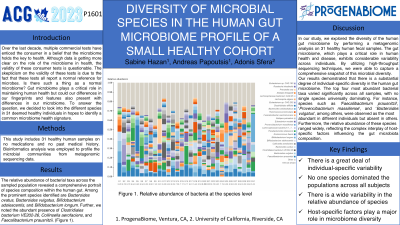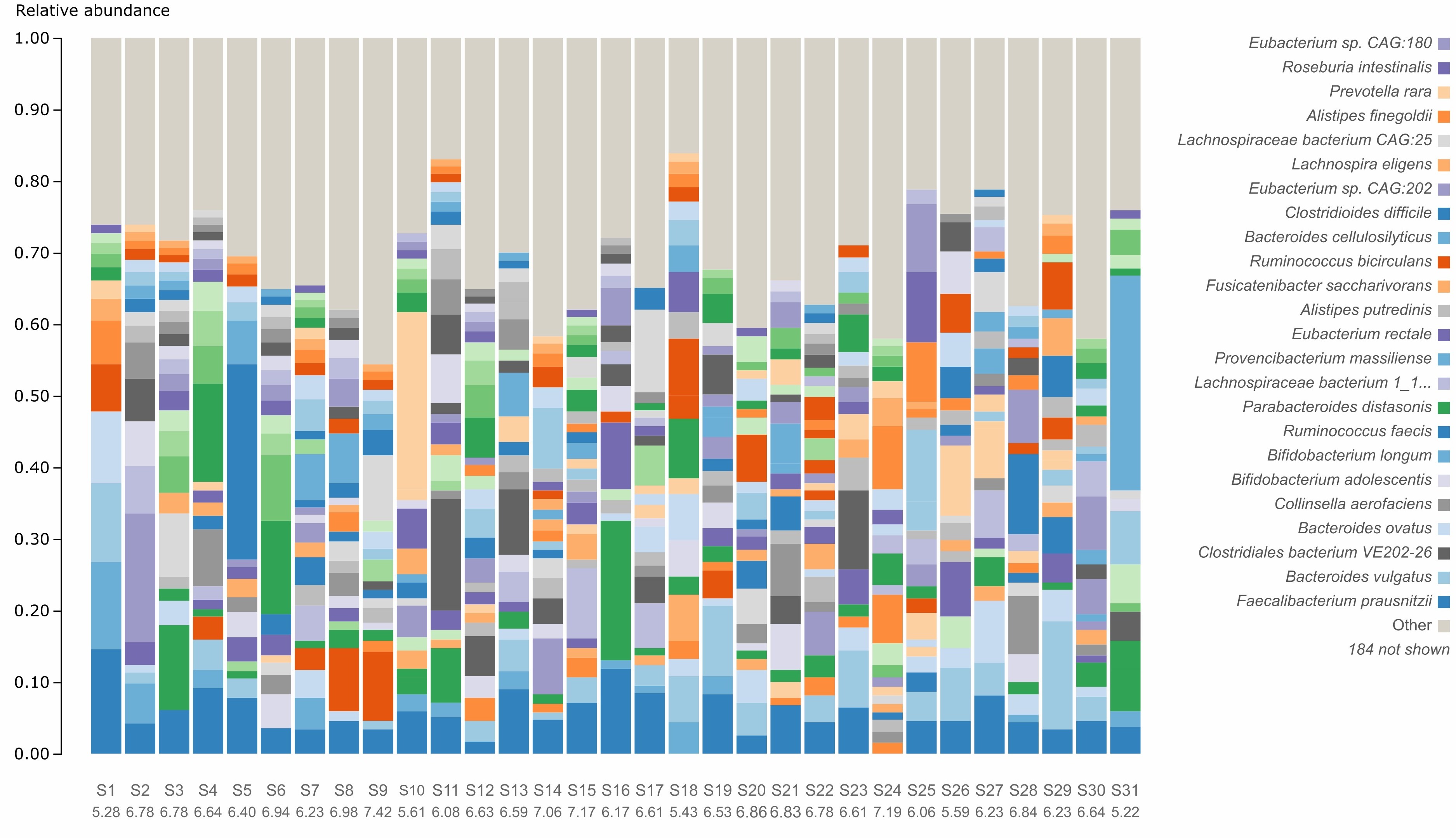Monday Poster Session
Category: Colon
P1601 - Diversity of Microbial Species in the Human Gut Microbiome Profile of a Small Healthy Cohort
Monday, October 23, 2023
10:30 AM - 4:15 PM PT
Location: Exhibit Hall

Has Audio

Sabine Hazan, MD
ProgenaBiome
Ventura, California
Presenting Author(s)
Sabine Hazan, MD1, Andreas Papousis, PhD1, Adonis Sfera, MD2
1ProgenaBiome, Ventura, CA; 2University of Southern California Riverside, Riverside, CA
Introduction: Over the last decade, multiple commercial tests have enticed the consumer in a belief that the microbiome holds the key to health. Although data is getting more clear on the role of the microbiome in health, the validity of these consumer tests is questionable. The skepticism on the validity of these tests is due to the fact that these tests all report a normal reference for microbes. Is there such a thing as a normal microbiome? Gut microbiome plays a critical role in maintaining human health but Could our differences in our fingerprints and features also present with differences in our microbiome. To answer the question, we decided to look into the different species in 31 deemed healthy individuals in hopes to identify a common microbiome health signature.
Methods: This study includes 31 healthy human samples on no medications and no past medical history. Bioinformatics analysis was employed to profile the microbial communities from metagenomic sequencing data.
Results: The relative abundance of bacterial taxa across the sampled population revealed a comprehensive portrait of species composition within the human gut. Among the prominent species identified are Bacteroides ovatus, Bacteroides vulgatus, Bifidobacterium adolescentis, and Bifidobacterium longum. Further, we noted the abundant presence of Clostridiales bacterium VE202-26, Collinsella aerofaciens, and Faecalibacterium prausnitzii. (Figure 1).
Discussion: In our study, we explored the diversity of the human gut microbiome by performing a metagenomic analysis on 31 healthy human fecal samples. The gut microbiome, which plays a critical role in human health and disease, exhibits considerable variability across individuals. By utilizing high-throughput sequencing techniques, we were able to capture a comprehensive snapshot of this microbial diversity.
Our results demonstrated that there is a substantial degree of individual-specific diversity in the human gut microbiome. The top four most abundant bacterial taxa varied significantly across all samples, with no single species universally dominating. For instance, species such as 'Faecalibacterium prausnitzii', 'Provencibacterium massiliense', and 'Bacteroides vulgatus', among others, were observed as the most abundant in different individuals but absent in others. Furthermore, the relative abundance of these species ranged widely, reflecting the complex interplay of host-specific factors influencing the gut microbiota composition.

Disclosures:
Sabine Hazan, MD1, Andreas Papousis, PhD1, Adonis Sfera, MD2. P1601 - Diversity of Microbial Species in the Human Gut Microbiome Profile of a Small Healthy Cohort, ACG 2023 Annual Scientific Meeting Abstracts. Vancouver, BC, Canada: American College of Gastroenterology.
1ProgenaBiome, Ventura, CA; 2University of Southern California Riverside, Riverside, CA
Introduction: Over the last decade, multiple commercial tests have enticed the consumer in a belief that the microbiome holds the key to health. Although data is getting more clear on the role of the microbiome in health, the validity of these consumer tests is questionable. The skepticism on the validity of these tests is due to the fact that these tests all report a normal reference for microbes. Is there such a thing as a normal microbiome? Gut microbiome plays a critical role in maintaining human health but Could our differences in our fingerprints and features also present with differences in our microbiome. To answer the question, we decided to look into the different species in 31 deemed healthy individuals in hopes to identify a common microbiome health signature.
Methods: This study includes 31 healthy human samples on no medications and no past medical history. Bioinformatics analysis was employed to profile the microbial communities from metagenomic sequencing data.
Results: The relative abundance of bacterial taxa across the sampled population revealed a comprehensive portrait of species composition within the human gut. Among the prominent species identified are Bacteroides ovatus, Bacteroides vulgatus, Bifidobacterium adolescentis, and Bifidobacterium longum. Further, we noted the abundant presence of Clostridiales bacterium VE202-26, Collinsella aerofaciens, and Faecalibacterium prausnitzii. (Figure 1).
Discussion: In our study, we explored the diversity of the human gut microbiome by performing a metagenomic analysis on 31 healthy human fecal samples. The gut microbiome, which plays a critical role in human health and disease, exhibits considerable variability across individuals. By utilizing high-throughput sequencing techniques, we were able to capture a comprehensive snapshot of this microbial diversity.
Our results demonstrated that there is a substantial degree of individual-specific diversity in the human gut microbiome. The top four most abundant bacterial taxa varied significantly across all samples, with no single species universally dominating. For instance, species such as 'Faecalibacterium prausnitzii', 'Provencibacterium massiliense', and 'Bacteroides vulgatus', among others, were observed as the most abundant in different individuals but absent in others. Furthermore, the relative abundance of these species ranged widely, reflecting the complex interplay of host-specific factors influencing the gut microbiota composition.

Figure:
Figure 1. Relative abundance of bacteria in species level
Figure 1. Relative abundance of bacteria in species level
Disclosures:
Sabine Hazan indicated no relevant financial relationships.
Andreas Papousis indicated no relevant financial relationships.
Adonis Sfera indicated no relevant financial relationships.
Sabine Hazan, MD1, Andreas Papousis, PhD1, Adonis Sfera, MD2. P1601 - Diversity of Microbial Species in the Human Gut Microbiome Profile of a Small Healthy Cohort, ACG 2023 Annual Scientific Meeting Abstracts. Vancouver, BC, Canada: American College of Gastroenterology.
